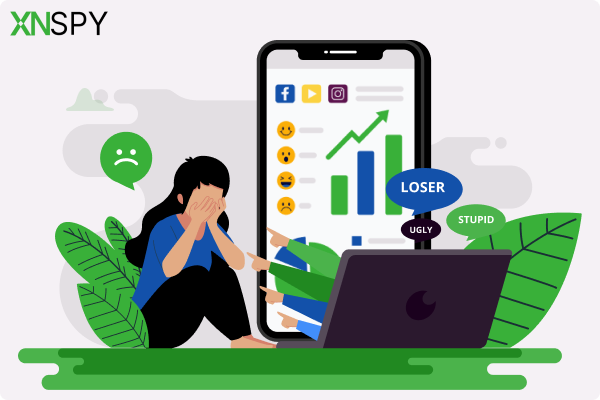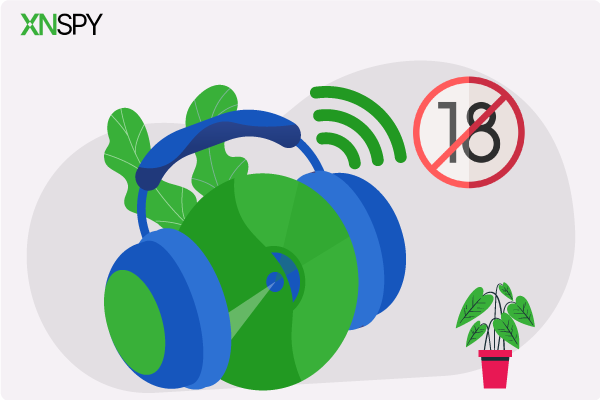The complete monitoring experience for your phone
Get XNSPY and start tracking calls, texts, multimedia, locations and more on any phone!
Get Started Now Live DemoToday’s tech-driven teens are more adept at understanding and using digital tools than their parents. It’s no wonder teens and preteens can easily dodge the restrictions parents apply to their tech usage.
According to Pew Research, 97% of teens use the Internet daily. Most use it for research, learning, and social connection. However, they may unintentionally or intentionally come across age-inappropriate content.
Modern parents have the dilemma of balancing their children’s right to the internet while safeguarding them. Most struggle to keep up with all the sneaky ways their kids can surf the internet. Some of those ways include private browsing modes, proxy websites, and deleting web history.
An online survey stated that 70% of teens hide their online behavior from their parents, and the best way to do that is to use Incognito mode to hide their browsing history. Many web browsers offer an InPrivate or Incognito mode where teens can browse the internet without leaving any evidence altogether.
It becomes difficult for parents to determine the content their kids search and consume online.
Why Kids Use Incognito Mode
Mobile devices provide teens with an easy way to access the internet at all times. Furthermore, private mode lets them keep their online habits under wraps. Some of the reasons why your child may use the incognito mode are
Hiding their Search History
Teens like to keep most of their online activities private as they move into the latter years of teenage. Incognito mode appeals to young as it allows them to search for something sensitive or personal without leaving a web trail.
Puberty, sexual relationships, and mental problems are some of the topics that kids want to search for without anyone else finding out about their searches.
Digital Freedom
As they age, kids want an online space where they can explore digital boundaries freely without judgment or restriction. Private mode gives them the luxury and convenience of engaging in content without worrying about parental oversight.
Avoid Marketing Ads
In this digital age, browsing the internet comes with a plethora of targeted promotions and ads. Teens may enable private browsing to save themselves from constant ads. The incognito mode prevents the websites from tracking their actions and using cookie data to send personalized ads.
What Parents Must Know of Incognito Mode?
Incognito mode is a feature of web browsers that allows users to browse the internet without leaving a trace. An incognito mode session is an online activity that does not save any login information, cookies, browsing history, or website data.
Apple first introduced private browsing in 2005, but now almost every web browser offers it under a different name. For example, it is called ‘Incognito Mode’ in Google Chrome, ‘Private Mode’ in Opera, ‘Private Browsing’ in Firefox, and ‘Private Window’ in Safari. Each browser has a different name, but the function of hiding the internet activity is the same.
Incognito mode works by setting up a temporary session that does not store any user activity. When the teen opens the private window, the browser does not save the URLs visited or the cookies and cache. Browsing in private mode is helpful for specific purposes, but that doesn’t make it 100% private.
Here is why:
Private Browsing is Not Entirely Private
Teenagers think using incognito mode gives their activities an invincibility cloak and ensures anonymity, but that’s not true. There is no record of the web pages they visit on the device they use. However, websites can track the IP address of the child’s device. Moreover, websites use analytics and cookie data to gather browsing habits.
If they log in to a particular website, that information is used by websites to know when and from where the account was accessed. Internet Service Providers (ISPs) also keep a clear record of daily Internet usage.
They can track the websites your child visits and the content they consume. Any web page the child bookmarks, or the file they download in private mode is also stored on the device.
No Safety from Online Threats
Incognito mode can compromise internet safety and offers little protection against online threats like phishing, malware, and scams. It can prevent cookies and other information from being stored on the device, but it cannot prevent cyber attacks or data from malicious websites. Your teen can easily click on a suspicious link or fall victim to a phishing scam.
The Dangers of Private Browsing
Screentime and unrestricted internet access are two notable challenges that parents face. The ubiquity of the internet, coupled with incognito mode, increases the possibility of risky online behavior. Teens could make sensitive searches and browse adult content without realizing the potential threats they are exposed to.
Let us know some of those.
Cyberbullying
Like kids, cyberbullies also use incognito mode to remain anonymous. They can interact with the teens and harass them without leaving any trace.
Lack of Online Protection
With regular browsing, many safety features work automatically and prevent any cyberattack. However, in private mode, the risks of malware increase tenfold. The information that the child enters can easily be used for phishing scams and identity theft.
No Parental Control
When kids use incognito mode, none of their browsing history is stored. Parents cannot discern what their children search for and the content they consume. The child will engage in unsafe online behavior without any consequence or guidance from their parents.
How Parents Can Monitor Kid’s Incognito Browsing
Installing a monitoring app on a child’s mobile device is one of the best ways to monitor their private browsing mode. XNSPY is a reliable parental monitoring app that provides insights into the child’s online habits, including activities in Incognito mode. The app is compatible with a wide array of Android and iOS devices.
XNSPY works in stealth mode and discreetly records the browsing activity when the child opens incognito mode. The recorded data is uploaded to the user dashboard in real-time. You must open the ‘Internet History’ in the Phone Logs section.
XNSPY lets you track browsing activity from mobile web browsers, whether Chrome on Android or Safari on iPhone.
The key information that the app provides includes:
- The list of all the websites opened in regular and private mode
- The number of times a particular website is visited
- Date and timestamp for each website
- The links that are stored as bookmarks
Besides internet history, XNSPY provides comprehensive tools to manage the child’s digital use and app activity. If the child uses Incognito mode to browse adult content, you can use watchlist alerts to stay informed.
XNSPY lets you define adult words and phrases that children might search for. You will get a notification whenever your child tries to search for inappropriate sexual content on their device.
Conclusion
Teenagers use various methods to conceal their online activities, and Incognito mode offers them the ideal way to do so. However, this practice can pose risks to their online safety. You must discuss online safety, privacy, and risks associated with using private mode for browsing. Remind them that even if they use Incognito mode, it leaves a digital footprint.
In this digital age, curiosity can get the better of most kids, and they can surreptitiously visit websites and make sensitive searches in Incognito mode. The best way to monitor this behavior is to install XNSPY on their mobile devices. The app lets you track internet history in both regular and private modes. You can effectively manage your child’s online behavior with additional features such as watchlist alerts.


